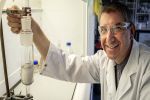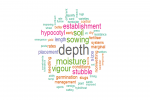Agronomists and grain growers say GRDC-supported study tours provide new insights to improve productivity and build networks
It was the rocks that impressed Elmore-based Nutrien Ag Solutions agronomist Greg Toomey on an Eyre Peninsula (EP) farm visit as part of a recent GRDC-supported grower and adviser study tour.
To be precise, it was the way those rocks had been smashed into inconsequential pebbles with the use of a Reefinator, a Western Australian-developed, tractor-pulled, hydraulic tyne implement.
“We went to a paddock that was full of boulders bigger than your head,” he says. “The land had been bought quite cheaply because it wasn’t considered suitable for cropping, but we were shown how the Reefinator had pulverised the rocks up to a point where the grower had turned the land that others had seen as impossible to do anything with into something productive. It was fascinating.”
Mr Toomey was one of nine Nutrien agronomists and 50 growers from Victoria and South Australia who travelled to the 2024 WeedSmart Week on the study tour.
Aimed at building knowledge to improve productivity and efficiencies in their own practices, the group attended the week in Port Lincoln followed by a field trip visiting growers from around the EP, including the Cummins property where the Reefinator was being demonstrated.
Mr Toomey says while the EP soils had greater variation and were, in some cases, notably less productive than their deep clay loams around Elmore, the trip provided a valuable insight into the potential of marginal land. He says this has had a tangible impact.
“I know of two cases where my growers are looking at buying blocks that they would not have considered before – what we might call second grade – and assessing whether it would be worth bringing them up to an appropriate level with amelioration works. We’re looking through a different lens than before we went.”
New perspectives
Fellow Nutrien agronomist James Falvey, who organised the tour for the Elmore growers, says the trip, which provided both ‘sit-down’ and practical learning, opened his eyes as an adviser as well.
“One thing that I gleaned is that no system is perfect and that different systems can work as long as you’ve got multiple levers to pull,” he says.
For example, the WeedSmart presentations showed there is a range of strategies that can be employed to combat ryegrass and herbicide resistance in a disc-dominated system (such as those that are common around the Elmore region) without needing to move to tynes.
“A big issue in our region is we’ve got growers who have disc seeders and that rules out the safe use of a number of pre-emergent chemicals to control ryegrass,” he says. “But going to the event opened my eyes that we don’t have to be rigid in thinking that moving to tynes is the only solution. There are other mechanisms we can use to combat ryegrass and ryegrass resistance such as crop competition, nutrition, rotations and even livestock.”
New connections
Along with hearing about such strategies and seeing innovations around weed control and soil improvement first-hand, there were other, personal benefits gained from the study tour, Mr Falvey says.
The group, comprising growers from a 50-kilometre radius around Elmore – and representing three generations and two footy teams – connected in new ways, building professional and personal networks.
These new relationships extended beyond their immediate region to other Nutrien growers on the tour and other event participants.
GRDC grower relations manager Charleton Glenn, who oversaw the sponsorship program, says these connections can last many years.
I was speaking to a NSW grower who went to WA on a GRDC study tour 10 years ago and they’re still mates with other participants and still talk about the trip because it gave them insights into new and different weed management practices. says Charleton Glenn.
This long-lasting network-building is an example of the value that GRDC sees in supporting study tours that provide growers with contacts and first-hand knowledge of best-practice agronomy that they can implement themselves.
“These study tours give growers and advisers the opportunity to ask questions and take home tangible information,” she says. “Whether it leads to practice change or a conversation with a neighbour – the value for GRDC is the information sharing and growers learning from other growers.”
Nuts and bolts
Groups can apply to get GRDC support for their study tour via the GRDC website. Help is available, if required, to guide people through the process.
At the conclusion of the tour a short milestone report is submitted including photographs, highlights and key lessons. “It’s a reporting mechanism so we can share what has been done with the next group of agronomists or advisers who want to take their growers somewhere,” Ms Glenn says. “It’s also important because it shows the value of GRDC study tours for the people who have participated.”
More information: To apply, view sponsorship grower and advisor study tours.

























































